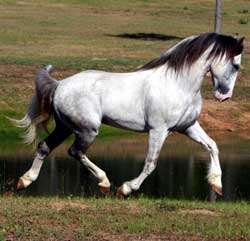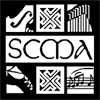

Maggies Irish Rebel, Crowndale Farm, Sealy, TX
The Celtic Horse
Long before the cowboy rode the wild west, horses were used all over Europe for transportation, working the land and in warfare.
In Gallo-Roman religion, Epona was a protector of horses, donkeys, and mules. She was particularly a goddess of fertility, as shown by her attributes of a patera, cornucopia, ears of grain and the presence of foals in some sculptures suggested that the goddess and her horses were leaders of the soul in the after-life ride.
Étaín is a figure of Irish mythology, best known as the herine of Tochmarc Étaíne, one of the oldest and richest stories of the Mythological Cycle. She is sometimes known by the epithet Echraide, ("horse rider"), suggesting links with horse deities and figures such as Rhiannon the horse goddess of Welsh mythology.
White horses (which are rarer than other colours of horse) have a special significance in the mythologies of cultures around the world. They are often associated with the sun chariot, with warrior-heroes, with fertility, or with an end-of-time saviour, but other interpretations exist as well. Both truly white horses and the more common grey horses, with completely white hair coats, were identified as "white" by various religious and cultural traditions. White horses are the most common type of hill figure in England. Though many are modern, the Uffington White Horse at least dates back to the Bronze Age.
The White Horse is the sign of the House of Hanover, adopted by many Eighteenth-Century inns to demonstrate loyalty to the new Royal dynasty. A white horse is also the emblem of the County of Kent. The name can also refer to the chalk horses carved into hillsides.
In Scottish folklore, the Kelpie or Each Uisge, a deadly supernatural water demon in the shape of a horse, is sometimes described as white, though other stories say it is black.
Celtic Horses
The Irish Sport Horse, also known as the Irish Hunter, is mainly the result of a cross between the Irish Draught and the Thoroughbred and has been given recognition as a separate breed. It is commonly bred from parents who are also Irish Sport Horses, in addition to being bred from the definitive parent breeds. It is traditionally used for all purposes, from transportation, to riding, and working the land. However, it is becoming increasingly popular as a competition riding horse. Its natural athletic ability and fantastic jumping talents means that it excels in the show jumping arena, as well as competing at the highest levels of eventing.
Draft Horses may have originated with primitive ancestors such as the Forest Horse or wild subspecies that may have descendants as diverse as the large Shire horse and the small but sturdy Shetland pony. These wild prototypes were adapted by natural selection to the cold, damp climates of northern Europe. Humans domesticated these horses and needed them to perform a variety of duties. One type of horse-powered work was the hauling of heavy loads, plowing fields, and other tasks that required pulling ability. A heavy, calm, patient, well-muscled animal was desired for this work.
The Clydesdale is a breed of draft horse derived from the farm horses of Clydesdale, Scotland, and named after that region. Thought to be over 300 years old, the breed was extensively used for pulling heavy loads in rural, industrial and urban settings, their common use extending into the 1960s when they were still a familiar sight pulling the carts of milk and vegetable vendors. The Budweiser Clydesdales are a famous example of this breed of horse.
The Irish Cob is one of the oldest recognized breeds in Ireland, along with the Connemara Pony and Irish Draught horse. It was established over many generations in Ireland by the Travellers (gypsies), and world wide has been called by many names like the Gypsy Cob, or Gypsy Vanner, although this is not what the Gypsies called their horses. Travellers in Ireland, Wales, England and Scotland, who bred their horses very selectively for a hundred years or more, did not keep written records, but have passed lineages on to proceeding generations verbally.
NTIF 2013 Spirit of the Celtic Horse
Equest
For over 30 years, Equest has delivered the benefits of equine therapy to thousands of North Texas children and adults with varying disabilities and special needs. Equest was the first, and continues to be one of the largest, therapeutic centers in Texas allowing us to provide a variety of equine-assisted programs to over 150 clients weekly.
Their mission is to empower, enrich and educate through horses. The physical and emotional accomplishments that their clients achieve are a direct result of the interaction and rhythmic motion that equine therapy provides. Riding a horse moves the body in a manner similar to a human gait, allowing riders with physical needs to realize improvement in muscle tone, strength, flexibility and balance. Additionally, their horse therapy programs allow riders to achieve cognitive, social and emotional improvements resulting in improved self-esteem, concentration and independence.
Equine In Line
Robert M. Liner, founder of and head trainer for Equine In Line, is C.H.A. certified in English, Western, and trail instruction, and has been an instructor and clinician for the past twenty-five years.
Since 1998, Robert has been the featured clinician at the State Fair of Texas. Each year, he performs over ninety training demonstrations at the Spirit of the Horse show. Using Intuitive Equine Guidance as his unique training method, Robert has trained thousands of horses and riders to overcome fears and reach their full potential.
Over the years, Robert's distinctive insight has earned him much acclaim. First as head horse trainer and entertainer for the world-famous South Fork Ranch, Robert is now often featured in various newspapers and magazines such as the Dallas Morning News and Dallas Observer. Additionally, he has been featured multiple times on local and national TV and radio.
His unique methods have inspired many horse trainers and owners to search for deeper meaning when working with horses and learn to understand the horse by going inside themselves. By observing body language, hairlines, and each horse's special personality, Robert uses intuition to further the human-equine connection. Seen through Robert's eyes, the world of horses becomes a bit more human.
Napitov and Tracy Caruth
Tracy's success with her stallion DA Napitov+/ continues with the Nap Kids she shows in multiple disciplines. Honors for herself and her horses include awards of distinction from AHA, USEF and Region 9.
Tracy indulges her passion for horses and philanthropy by taking on projects that reach beyond the farm and the show ring. With her unique style and panache, Tracy is actively involved in helping make dreams a reality for the Dallas Mounted Police Unit. Her dedication to both projects brings a new dimension to Tracy's commitment to her city and her horses, and is helping to change the face of Dallas today and improve it for tomorrow.
Life is always busy on a horse farm and Caruth Arabians is no exception. With the 2012 show season coming up, there's never a dull moment at the ranch. Owner, Tracy Caruth believes that breeding and showing her Arabians and Half-Arabians should be as much fun as it is hard work and perseverance. Tracy has a passion for her horses and their welfare and it carries over into everything she does. There are no half measures on this farm!
Futurity horses and three-year-olds will be debuting in the show ring, while some of the older horses are getting more experience - and ribbons- under their belts. Beautiful foals are on the way, bringing in a new generation to the DA Napitov+/ program. To see the latest arrivals at the ranch and visit some of the seasoned show horses, just call the farm and come on by to visit.
Dallas Mounted Police
The Dallas Mounted Unit began at the urging of officers frustrated by a rash of burglaries in Pleasant Grove. Several officers asked permission to patrol the neighborhood on their own horses. When they did, the burglaries stopped. Mounted officers are particularly effective in deterring burglaries, because they can peer into back yards from atop their horses – which generally stand at least 16 hands high (about 5 feet from the ground to the horse's back). And because horses don't move as fast as cars, criminals know the mounted officers will be in the area awhile.
The Dallas unit is also one of the more elite units in the country, according to Sgt. Michael Hunter, the unit's supervisor. Openings in the unit are rare, but when they do occur and typically 25 to 30 Dallas police officers apply. Surprisingly, applicants are not required to have riding experience or familiarity with horses.
Officers undergo six weeks of training, which they describe as grueling, and many later go to Canada to study with the famed Royal Canadian Mounted Police. In addition to spending four to five hours a day in the saddle, often in searing heat or numbing cold, officers must care for their mounts, grooming and saddling them each morning and afternoon at the department's stables in Fair Park. The 25 horses, primarily sturdy quarter horses, also undergo three weeks of initial training. Training includes riding past smoky bales of hay; getting accustomed to the sounds of guns fired from their backs or firecrackers popping nearby; and riding through lighted flares that might be found at accident scenes or into draped banners and flags similar to a parade environment.
Work assignments for the mounted unit are varied. One week the unit may patrol the downtown business district; the next week it may be assigned to a residential neighborhood or a shopping mall. Officers carry ticket books in their saddlebags, and while they can't run down a speeding car, they do stop motorists for infractions such as failure to wear a seat belt. Their main responsibility however, is to aid patrol officers. That might mean searching for a missing person or chasing down a suspect. If a suspect is caught, the officers have handcuffs attached to a tether, so they can lead suspects to custody without dismounting.
Officers wear a Smokey Bear-style "campaign" hat, riding breeches and lace-up boots with spurs that don't jingle. Their saddles are Australian stock style, not Western saddles with a saddle horn, unlike the Fort Worth Police Department that remains true to its heritage using Western saddles, and cowboy hats and boots!
Bluebonnet Arabians
The Bluebonnet Arabian Horse Club is dedicated to promoting our beloved Arabians and Half-Arabians. At the same time, they welcome owners of Non-Arabians to join our club, participate in our events and activities and enjoy the fellowship of being with other horse enthusiasts.
Whether your desire is to be the best of your chosen discipline in the A rated shows, to simply enjoy the relaxing fun shows or a trail ride with a group of friends, or you just enjoy being involved in a horse filled environment...they are the club with something for everyone.
Join them for open shows, dressage schooling shows and non-show related get-togethers (trail rides, parades, clinics, etc.) and other activities for Arabian, Half-Arabian and Non Arabian horses and owners in Dallas-Fort Worth and surrounding areas.
Minis And Friends
Minis and Friends is a 501(c)(3) non-profit organization. They are a group of caring people and horse lovers dedicated to sharing the love and spirit of miniature horses to those who need special, tender care. Their organization was specially created by a group of friends who wanted to share this exciting equine experience with you.
Minis and Friends is dedicated to bringing our mobile herd of trained miniature horses to visit and interact with people of all ages who may be suffering mentally, physically or emotionally. Their unique programs tailor activities for children with disabilities, at-risk youth, individuals in transition and elder adults to improve their motor skills, ability to connect, tactile response, use of senses and spirits through interaction with miniature horses.
